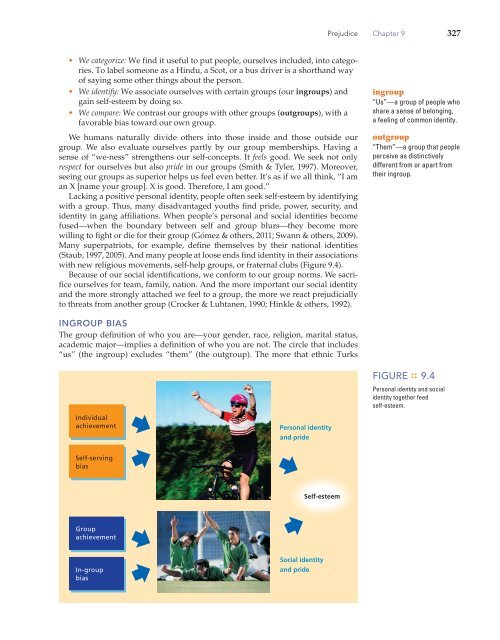Chapter 9: Prejudice: Disliking Others (2947.0K) - Bad Request
Chapter 9: Prejudice: Disliking Others (2947.0K) - Bad Request
Chapter 9: Prejudice: Disliking Others (2947.0K) - Bad Request
Create successful ePaper yourself
Turn your PDF publications into a flip-book with our unique Google optimized e-Paper software.
• We categorize: We find it useful to put people, ourselves included, into categories.<br />
To label someone as a Hindu, a Scot, or a bus driver is a shorthand way<br />
of saying some other things about the person.<br />
• We identify: We associate ourselves with certain groups (our ingroups ) and<br />
gain self-esteem by doing so.<br />
• We compare: We contrast our groups with other groups ( outgroups ), with a<br />
favorable bias toward our own group.<br />
We humans naturally divide others into those inside and those outside our<br />
group. We also evaluate ourselves partly by our group memberships. Having a<br />
sense of “we-ness” strengthens our self-concepts. It feels good. We seek not only<br />
respect for ourselves but also pride in our groups (Smith & Tyler, 1997). Moreover,<br />
seeing our groups as superior helps us feel even better. It’s as if we all think, “I am<br />
an X [name your group]. X is good. Therefore, I am good.”<br />
Lacking a positive personal identity, people often seek self-esteem by identifying<br />
with a group. Thus, many disadvantaged youths find pride, power, security, and<br />
identity in gang affiliations. When people’s personal and social identities become<br />
fused—when the boundary between self and group blurs—they become more<br />
willing to fight or die for their group (Gómez & others, 2011; Swann & others, 2009).<br />
Many superpatriots, for example, define themselves by their national identities<br />
(Staub, 1997, 2005). And many people at loose ends find identity in their associations<br />
with new religious movements, self-help groups, or fraternal clubs ( Figure 9.4 ).<br />
Because of our social identifications, we conform to our group norms. We sacrifice<br />
ourselves for team, family, nation. And the more important our social identity<br />
and the more strongly attached we feel to a group, the more we react prejudicially<br />
to threats from another group (Crocker & Luhtanen, 1990; Hinkle & others, 1992).<br />
INGROUP BIAS<br />
The group definition of who you are—your gender, race, religion, marital status,<br />
academic major—implies a definition of who you are not. The circle that includes<br />
“us” (the ingroup) excludes “them” (the outgroup). The more that ethnic Turks<br />
Individual<br />
achievement<br />
Self-serving<br />
bias<br />
Group<br />
achievement<br />
In-group<br />
bias<br />
Personal identity<br />
and pride<br />
Self-esteem<br />
Social identity<br />
and pride<br />
<strong>Prejudice</strong> <strong>Chapter</strong> 9 327<br />
ingroup<br />
“Us”—a group of people who<br />
share a sense of belonging,<br />
a feeling of common identity.<br />
outgroup<br />
“Them”—a group that people<br />
perceive as distinctively<br />
different from or apart from<br />
their ingroup.<br />
FIGURE :: 9.4<br />
Personal identity and social<br />
identity together feed<br />
self-esteem.

















